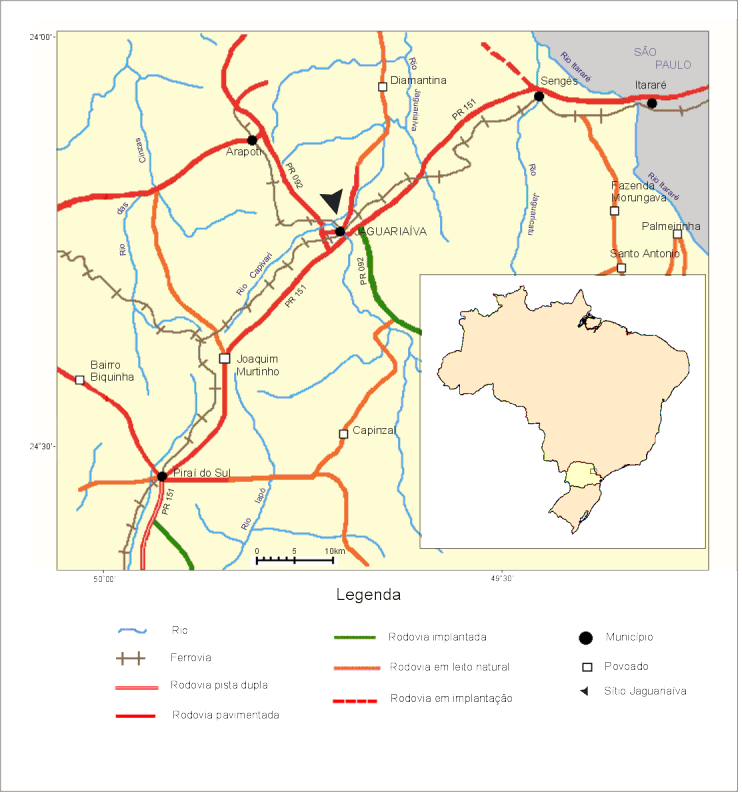Assine,M.L. 1996. Aspectos da Estratigrafia
das Seqüências Pré-Carboníferas da Bacia do Paraná no Brasil. Instituto de
Geociências, Universidade de São Paulo, São Paulo, Tese de Doutorado, 207p.
Azevedo, I. 1996. Considerações Tafonômicas
sobre os Ostracodes da Formação Ponta Grossa (Devoniano). In: Simpósio Sul
Americano do Siluro-Devoniano: Estratigrafia e Paleontologia, 1, Ponta Grossa,
Anais:141-145.
Barcellos-Popp, M.T. 1985. Revisão dos
Trilobitas Calmoniideos e Comunidades Faunísticas da Formação Ponta Grossa, Devoniano,
no Estado do Paraná. Curso de Pós-Graduação em Geociências, Universidade Federal
do Rio Grande do Sul, Porto Alegre, Tese de Doutorado, 112p.
Bolzon, R.T.;
Bogo, M. 1996. Tafonomia dos
Crinoidea da Formação Ponta Grossa, Estado do Paraná - Análise Preliminar.
In: Simpósio Sul Americano do Siluro-Devoniano:
Estratigrafia e Paleontologia, 1, Ponta Grossa, Anais: 363-369.
Bolzon, R.T.;
Scheffler, S.M. 1997. Crinóides
Devonianos da Formação Ponta Grossa, Estado do Paraná, Brasil. In: Congresso
Brasileiro de Paleontologia, 15, São Pedro,
1997, Boletim de Resumos:57.
Bosetti, E.P. 1989. Paleontologia dos Lingulida
(Brachiopoda: Inarticulata) da Formação Ponta Grossa, Devoniano, Bacia do Paraná.
Brasil. Curso de Pós-Graduação em Geociências, Universidade Federal do Rio Grande
do Sul, Porto Alegre, Dissertação de Mestrado, 136p.
Ciguel, J.H.G. 1989. Bioestratigrafia dos
Tentaculitoidea no Flanco Oriental da Bacia do Paraná e sua Ocorrência na América do
Sul (Ordoviciano-Devoniano). Instituto de Geociências, Universidade de São Paulo,
São Paulo, Dissertação de Mestrado, 237p. v.1 e 2.
Ciguel, J.H.G.;
R"osler, O.; Hofmeister, R.M.
1987. Preservação Parcial da Concha de Tentaculites crotalinus da Formação
Ponta Grossa. Boletim do Instituto de Geociências, Universidade de São Paulo,
São Paulo, 18:17-26.
Clarque, J.M. 1913. Fósseis Devonianos do Paraná.
Monographia do Serviço Geológico e Mineralógico do Brasil. Rio de Janeiro, v.1,
353p.
Cruz, N.M.C.;
Soares, O. 1996. Associações
Palinológicas do Devoniano do Estado do Paraná. In:
Simpósio Sul Americano do Siluro-Devoniano: Estratigrafia e Paleontologia, 1, Ponta Grossa,
Anais: 45-54.
Daemon, R.F.;
Quadros. L.P.; Silva, L.C. 1967.
Devonian Palynology and Biostratigraphy of the Paraná Basin. Boletim Paranaense de
Geociências, Curitiba, (21/22):.99-132.
Diniz, M.N. 1985. Interpretação Ambiental da
Formação Ponta Grossa na Parte Central da Bacia do Paraná - Um Estudo de Subsuperfície.
Instituto de Geociências, Universidade de São Paulo, São Paulo, Dissertação de
Mestrado, 148p.
Dino, R. 1999. Palynostratigraphy of the Silurian
and Devonian Sequence of the Paraná Basin, Brazil. In: Rodrigues, M.A.C.; Pereira, E.
(eds.) Ordovician-Devonian Palynostratigraphy in Western Gondwana: Update,
Problems and Perspectives. Rio de Janeiro, UERJ, Faculdade de Geologia, p.27-62.
ESTADO DO PARANÁ. 1996. Mapa do Estado do
Paraná. Curitiba, Secretaria de Estado do Meio Ambiente - Coordenadoria de Terras,
Cartografia e Cadastro, escala 1:1.000.000.
Fernandes, A. C.S. 1996. Os Icnofósseis do
Ordoviciano, Siluriano e Devoniano da Bacia do Paraná. Instituto de Geociências,
Universidade Federal do Rio de Janeiro, Rio de Janeiro, Tese de Doutorado, 183p.
Grahn, Y. 1997. Bioestratigrafia do Devoniano na
Faixa de Afloramentos na Borda Leste da Bacia do Paraná. In: Simpósio sobre
a Cronoestratigrafia da Bacia do Paraná, 3, Barra do Garças, 1997.
UERJ, Boletim de Resumos: 10.
Grahn, Y. 1999. Recent Progress in the Silurian
and Devonian Chitinozoan Biostratigraphy of the Paraná Basin in Brazil and Paraguay.
In: Rodrigues, M.A.C.; Pereira, E.
(eds.) Ordovician-Devonian Palynostratigraphy in
Western Gondwana: Update, Problems and Perspectives. Rio de Janeiro, UERJ, Faculdade
de Geologia, p.147-164.
Koslowski, R. 1913. Fossiles Dévoniens de L'État
de Paraná (Brésil). Annales de Paléntologie, Paris, 8: 105-123.
Kotzian, C.B. 1995. Estudo Sistemático e
Morfo-funcional de Bivalves (Mollusca) das Formações Vila Maria (Siluriano) e Ponta
Grossa (Devoniano), Bacia do Paraná, Brasil: Interpretação do Regime Hidrodinâmico
Sedimentar. Curso de Pós-Graduação em Geociências, Universidade Federal do Rio
Grande do Sul, Porto Alegre, Tese de Doutorado, 377p.
Kotzian, C.B.;
Marchiorio, A. 1997. Gastrópodes
(Mollusca) Devonianos da Formação Ponta Grossa no Estado do Paraná (Bacia do Paraná):
Gênero Ptomatis Clarke, 1899, Pleurotomaria (?) Defrans, 1826 e Platyceras
Conrad, 1840. Revista Ciência e Natura, Santa Maria, 19: 77-117.
Lange,F.W. 1967. Biostratigraphic Subdivision and
Correlation of the Devonian in the Paraná Basin. Boletim Paranaense de Geociências,
Curitiba, (21/22): 63-98.
Lange,F.W.; Petri, S. 1967. The Devonian of the
Paraná Basin. Boletim Paranaense de Geociências, Curitiba, (21/22): 5-55.
Marchioro, A.;
Kotzan, C.B.; Ilha Simões, R.
1998. Belerofontinas (Mollusca: Gastropoda?) Devonianos do Estado do Paraná (Formação
Ponta Grossa, Bacia do Paraná): Gênero Bucanella Meek, 1871. Revista Ciência
e Natura, Santa Maria, 20: 143-185.
Melo, J.H.G. 1985. A Província
Malvinocáfrica no Devoniano do Brasil; Estado Atual de Conhecimentos. Faculdade de
Geologia, Universidade Federal do Rio de Janeiro, Rio de Janeiro, Dissertação de
Mestrado, 890p.
Melo, J.H.G. 1988. The Malvinokaffric Realm in
the Devonian of Brazil. In: McMILLAN, N.J., EMBRY, A .F.; GLASS, D.J. (eds.). Devonian
of the World. Canadian Society of Petroleum Geologists, Memoir 14:669-703.
Morsch, S.M. 1986. Bivalves (Mollusca) da
Formação Ponta Grossa (Bacia do Paraná - Devoniano); Revisão Sistemática. Anais da
Academia Brasileira de Ciências, Rio de Janeiro, 58: 403-431.
Oliveira, E.P.1927. Geologia e Recursos Minerais
do Estado do Paraná. Monographia do Serviço Geológico e Mineralógico do Brasil,
Rio de Janeiro, 6, 172p.
Paiva, G. 1941. Relatório Anual do Diretor - Ano
de 1939. Departamento de Geologia e Mineralogia, Rio de Janeiro, 110p.
Petri, S. 1948. Contribuição ao Estudo do
Devoniano Paranaense. Departamento Nacional de Produção Mineral -DGM, 129,
125p.
Pinto, I.D.;
Purper, I. 1986. A Devonian Ostracode
from Ponta Formation, Paraná Basin, Brazil. Pesquisas, Porto Alegre, 18: 31-38.
Popp, J.H.; Barcellos-Popp, M.T. 1986. Análise
Estratigráfica da Seqüência Deposicional Devoniana da Bacia do Paraná (Brasil). Revista
Brasileira de Geociências, 16 ( 2): 187-194.
Sommer, F.W. 1954. Contribuição a
Paleofitogeografia do Paraná. In: LANGE, F.W (ed.) Volume Comemorativo do 1o
Centenário do Estado do Paraná. Curitiba, Comissão Comemorativa do Centenário do
Paraná, p.175-194.


